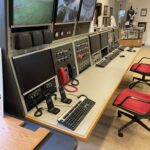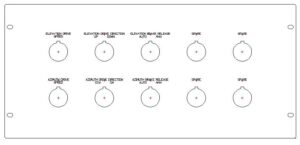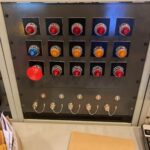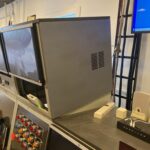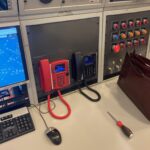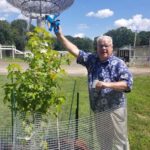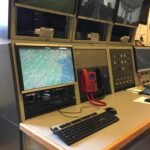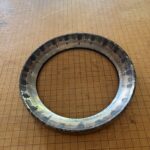Work on the control console continues, the VHF and UHF radios were racked, along with the upgraded speakers and microphones
Dennis Blazak is happy to report the sweet-gum tree grown from a seed that orbited the moon has reached 6 feet in height.
During the Artemis I mission, NASA sent 2,000 seeds from various tree species around the far side of the moon, marking the furthest any living organism has traveled from Earth and returned.
After careful review of hundreds of applications, NASA selected InfoAge to receive a ‘Moon Tree’ seedling. It is very appropriate to plant a moon seedling at the historic site of Project Diana. Project Diana, named for the goddess of the moon, bounced the first RADAR signal off the moon in 1946 proving radio communications in space was possible.
Dennis and Frank O’Brien (NASA Solar System Ambassador) are the InfoAge volunteers who sponsored and care for this unique tree at the special historic space exploration site.
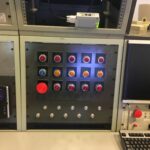
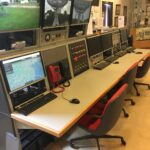 A new network switch was racked to support the SDR and telescope control computers
A new network switch was racked to support the SDR and telescope control computers
The status lamps and controls for the VHF antenna mount were installed
The RF metering panel was installed
Another IP security camera was prepped for installation
ADS-B Remote Aircraft Position Receiver Installed
ADS-B is an airspace surveillance system which could eventually replace Secondary surveillance radar as the main surveillance method for controlling aircraft worldwide. In the United States ADS-B is an integral component of the NextGen national airspace strategy for upgrading and enhancing aviation infrastructure and operations.
ADS-B enhances safety by making an aircraft visible, in real-time, to air traffic control (ATC) , ground stations (as at ISEC) and to other ADS-B In equipped aircraft with position and velocity data transmitted every second.
Full motion operation of the TLM-18 is expected in early September
The team removed the elevation drive and have diagnosed the issue – a bearing had failed, the replacement is being identified and sourced.
Photo is the race portion of the failed bearing assembly showing scoring and damage.
TLM-18 Control console upgrades continue
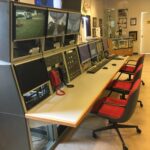 The four console modules to the rear were recovered from the RRSat (formerly AT&T) Earth Station in Hawley PA by OMARC in June of 2014, the three modules closer to the camera were sourced by CDL in 2023 via another individual whom had also acquired surplus equipment from the Hawley location in 2014.
The four console modules to the rear were recovered from the RRSat (formerly AT&T) Earth Station in Hawley PA by OMARC in June of 2014, the three modules closer to the camera were sourced by CDL in 2023 via another individual whom had also acquired surplus equipment from the Hawley location in 2014.
The new work surface was fabricated by Steve Lang and Fred Carl, utilizing brackets that were replicated from the existing hardware by CDL.
The new rack panels were designed in CAD and cut on a computer-controlled laser, The finish color was matched to the existing by My Perfect Color
Display system issues resolved
An ongoing issue with the the large-format monitors was diagnosed, the root cause was a defective video connector on one of the computers (SDR5). Both monitors are back in service.
New communications equipment installed
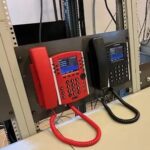 New phones were installed, one on the Camp Evans network, with a second being a dedicated order line (the red phone) to link ISEC to other EME capable facilities.
New phones were installed, one on the Camp Evans network, with a second being a dedicated order line (the red phone) to link ISEC to other EME capable facilities.
Moon Tree arrives at ISEC
 The InfoAge Science and History Museums has received a tree whose seed traveled on a 500,000 mile, 25 day journey around the Moon during November-December 2022.
The InfoAge Science and History Museums has received a tree whose seed traveled on a 500,000 mile, 25 day journey around the Moon during November-December 2022.
The mission, Artemis 1, was the very first test of a new spacecraft (named Orion) that will carry humans back to the moon this decade, as well as the first flight of a huge new rocket, called SLS (Space Launch System). In a flight that was nearly flawless, key technologies were proven that will be necessary for the next generation of lunar astronauts.
Carried aboard the Artemis 1 spacecraft were packets containing about 3,000 seeds from five varieties of trees. When Artemis 1 returned to Earth, the seeds were germinated, grown into saplings and are now being distributed. We have received a sweetgum, which is native to New Jersey, and is known for its beautiful foliage in the fall.
The Artemis Moon Trees are being distributed to museums, education centers and a number of government organizations. An extensive application process was required, which required a detailed community and education outreach plan, and the ability to protect and care for the tree. Infoage was notified recently about our selection, with NASA commenting:
“An extensive review of more than 1300 applications was conducted jointly by the NASA Office of STEM Engagement and the USDA Forest Service, and your combined education impact statement and tree care plan distinguished your application as a top candidate.”
SES AMERICOM Donation
Societe Europeenne des Satellites (SES) is a major satellite communication company headquartered in Luxembourg with a fleet of over seventy medium and low earth orbit spacecraft. When the SES teleport in Princeton NJ closed down in 2023, various display materials were donated to ISEC to illustrate that company’s contribution to space communications.
Donations included three large rocket models highlight the international nature of communication satellite launch services in the late 20th and early 21st centuries. A variety of public relations materials such as posters, small models, and pins show how SES expanded the peaceful commercial use of space, inaugurated by it’s predecessor, the RCA Astro-Electronics TIROS 1 project in 1960.
Several computer displays and (sanitized) computer workstations were also donated to help create interactive exhibits in the museum.
New position check monitors installed, second UPS system is on line
The team also installed the position-check monitors in the upper console, along with a dedicated monitor for the NOAA APT weather system.
The second UPS system was also racked, and wired to it’s dedicated power distribution system (PDU).
New console sections fitted
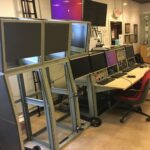
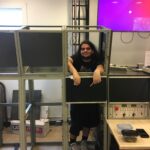 The ISEC console is compromised of Winsted System 85 modules. The series went end of sale in 2015, shortly after the first 4 sections were acquired.
The ISEC console is compromised of Winsted System 85 modules. The series went end of sale in 2015, shortly after the first 4 sections were acquired.
This presented an issue as the small parts (rails, ties, and work surface supports) needed to re-created from scratch, right down to the drawings!
